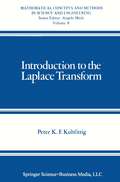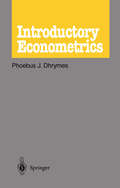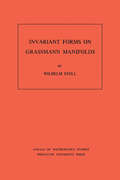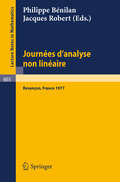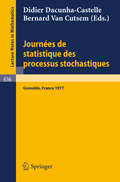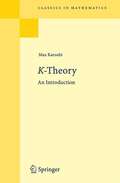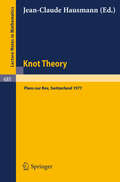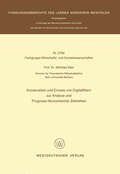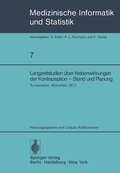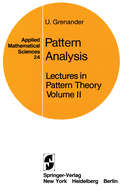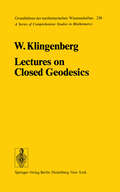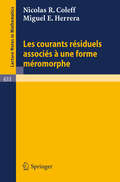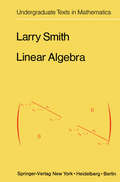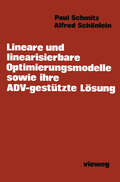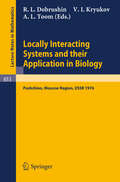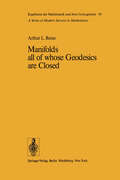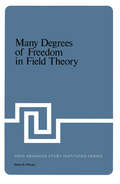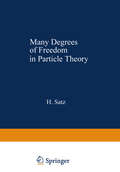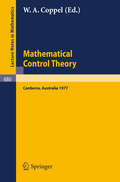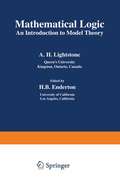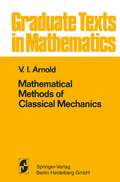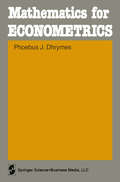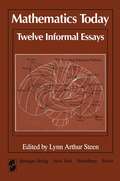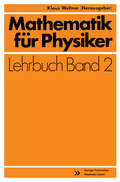- Table View
- List View
Introduction to the Laplace Transform (Mathematical Concepts and Methods in Science and Engineering #8)
by Peter K.F. KuhfittigThe purpose of this book is to give an introduction to the Laplace transform on the undergraduate level. The material is drawn from notes for a course taught by the author at the Milwaukee School of Engineering. Based on classroom experience, an attempt has been made to (1) keep the proofs short, (2) introduce applications as soon as possible, (3) concentrate on problems that are difficult to handle by the older classical methods, and (4) emphasize periodic phenomena. To make it possible to offer the course early in the curriculum (after differential equations), no knowledge of complex variable theory is assumed. However, since a thorough study of Laplace. transforms requires at least the rudiments of this theory, Chapter 3 includes a brief sketch of complex variables, with many of the details presented in Appendix A. This plan permits an introduction of the complex inversion formula, followed by additional applications. The author has found that a course taught three hours a week for a quarter can be based on the material in Chapters 1, 2, and 5 and the first three sections of Chapter 7. If additional time is available (e.g., four quarter-hours or three semester-hours), the whole book can be covered easily. The author is indebted to the students at the Milwaukee School of Engineering for their many helpful comments and criticisms.
Introductory Econometrics
by P. J. DhrymesThis book has taken form over several years as a result of a number of courses taught at the University of Pennsylvania and at Columbia University and a series of lectures I have given at the International Monetary Fund. Indeed, I began writing down my notes systematically during the academic year 1972-1973 while at the University of California, Los Angeles. The diverse character of the audience, as well as my own conception of what an introductory and often terminal acquaintance with formal econometrics ought to encompass, have determined the style and content of this volume. The selection of topics and the level of discourse give sufficient variety so that the book can serve as the basis for several types of courses. As an example, a relatively elementary one-semester course can be based on Chapters one through five, omitting the appendices to these chapters and a few sections in some of the chapters so indicated. This would acquaint the student with the basic theory of the general linear model, some of the prob lems often encountered in empirical research, and some proposed solutions. For such a course, I should also recommend a brief excursion into Chapter seven (logit and pro bit analysis) in view of the increasing availability of data sets for which this type of analysis is more suitable than that based on the general linear model.
Invariant Forms on Grassmann Manifolds. (AM-89), Volume 89
by Wilhelm StollThis work offers a contribution in the geometric form of the theory of several complex variables. Since complex Grassmann manifolds serve as classifying spaces of complex vector bundles, the cohomology structure of a complex Grassmann manifold is of importance for the construction of Chern classes of complex vector bundles. The cohomology ring of a Grassmannian is therefore of interest in topology, differential geometry, algebraic geometry, and complex analysis. Wilhelm Stoll treats certain aspects of the complex analysis point of view. This work originated with questions in value distribution theory. Here analytic sets and differential forms rather than the corresponding homology and cohomology classes are considered. On the Grassmann manifold, the cohomology ring is isomorphic to the ring of differential forms invariant under the unitary group, and each cohomology class is determined by a family of analytic sets.
Journees d'Analyse Non Lineaire: Proceedings, Besancon, France, June 1977 (Lecture Notes in Mathematics #665)
by Philippe Bénilan Jacques RobertJournees de Statistique des Processus Stochastiques: Proceedings, Grenoble, juin 1977 (Lecture Notes in Mathematics #636)
by Didier Dacunha-Castelle Bernard Van CutsemK-Theory: An Introduction (Classics in Mathematics)
by Max KaroubiFrom the Preface: K-theory was introduced by A. Grothendieck in his formulation of the Riemann- Roch theorem. For each projective algebraic variety, Grothendieck constructed a group from the category of coherent algebraic sheaves, and showed that it had many nice properties. Atiyah and Hirzebruch considered a topological analog defined for any compact space X, a group K{X) constructed from the category of vector bundles on X. It is this ''topological K-theory" that this book will study. Topological K-theory has become an important tool in topology. Using K- theory, Adams and Atiyah were able to give a simple proof that the only spheres which can be provided with H-space structures are S1, S3 and S7. Moreover, it is possible to derive a substantial part of stable homotopy theory from K-theory.The purpose of this book is to provide advanced students and mathematicians in other fields with the fundamental material in this subject. In addition, several applications of the type described above are included. In general we have tried to make this book self-contained, beginning with elementary concepts wherever possible; however, we assume that the reader is familiar with the basic definitions of homotopy theory: homotopy classes of maps and homotopy groups.Thus this book might be regarded as a fairly self-contained introduction to a "generalized cohomology theory".
Knot Theory: Proceedings, Plans-sur Bex, Switzerland 1977 (Lecture Notes in Mathematics #685)
by J. C. HausmannDedicated to the Memory of Christos Demetriou Papakyriakopoulos, 1914-1976
Konstruktion und Einsatz von Digitalfiltern zur Analyse und Prognose ökonomischer Zeitreihen (Forschungsberichte des Landes Nordrhein-Westfalen)
by Winfried StierLangzeitstudien über Nebenwirkungen der Kontrazeption — Stand und Planung: Symposion der Studiengruppe „Nebenwirkungen oraler Kontrazeptiva — Entwicklungsphase“. München, 27. – 29 September 1977 (Medizinische Informatik, Biometrie und Epidemiologie #7)
by U. KellhammerVerhandlungsberichte wissenschaftlicher Symposien sind nicht in al len Fällen eine Publikation wert. Daß wir uns im vorliegenden Fall für eine Publikation entschieden haben, hat eine Reihe gewichtiger Gründe. Die Frage nach mehr oder weniger gravierenden Nebenwirkungen der oralen Kontrazeption ist immens wichtig für alle Frauen. Wenn sich die wissenschaftliche Gynäkologie in der Beurteilung dieser Fragen irrt, wird sie einen starken Vertrauensschwund hinnehmen müssen. Auch der Staat, der die Bürger nicht hinreichend orientiert und schützt, ist bei einer so weitreichenden Frage der Volksgesundheit zumindest indirekt betroffen. Nebenwirkungen treten erst im fortgeschrittenen Alter mit einer Ver zögerung von mehr als einem Jahrzehnt auf. Die deutsche weibliche Be vö1kerung wächst in den nächsten 10 Jahren in diese Risikosituation voll hinein. Bisher sind noch ca. 40% der weiblichen Bevölkerung ab 35 Jahre ohne Erfahrung mit der Pille. In 10 Jahren werden nahezu alle Frauen die Pille mehr oder weniger lange genommen haben. Wenn gravierende Langzeit-Nebenwirkungen vorhanden sind, muß das Netz der Untersuchungen, um sie möglichst rechtzeitig zu erkennen, jetzt ge spannt werden. Großstudien lassen sich nicht sofort aus dem Boden stampfen. Sie er fordern eine mehr oder weniger lange Entwicklungsphase. Die Entwick lungsphase zu einer deutschen Langzeitstudie, über die hier berich tet werden soll, dauert nunmehr drei Jahre. Die Erfahrungen einer Entwicklungsphase sind für andere derartige Projekte sicher wertvoll. Teil der Strategie von Entwicklungsphasen für Großstudien auf epide miologischem Sektor ist die Einbeziehung internationaler Erfahrungen.
Lectures in Pattern Theory: Volume 2: Pattern Analysis (Applied Mathematical Sciences #24)
by U. GrenanderMany persons have helped the author with comments and corrections, and I would like to mention D. E. McClure, I. Frolow, J. Silverstein, D. Town, and especially W. Freiberger for his helpful suggestions and encouragement. The work in Chapters 6 and 7 has been influenced and stimulated by discussions with other members of the Center for Neural Sciences, especially with L. Cooper and H. Kucera. I would like to thank F. John, J. P. LaSalle, L. Sirovich, and G. Whitham for accepting the manuscript for the series Applied Mathematical Sciences published by Springer-Verlag. This research project has been supported by the Division of Mathematical and Computer Sciences of the National Science Foundation and (the work on language abduction, pattern processors, and patterns in program behavior) by the Information Systems Program of the Office of Naval Research. I greatly appreciate the understanding and positive interest shown by John Pasta, Kent Curtiss, Bruce Barnes, Sally Sedelov vi PREFACE and Bob Agins of the Foundation, and by Marvin Denicoff of the Office of Naval Research. I am indebted to Mrs. E. Fonseca for her untiring and careful preparation of the manuscript, to Miss E. Addison for her skillful help with the many diagrams, and to S.V. Spinacci for the final typing. I gratefully acknowledge permission to reproduce figures, as mentioned in the text, from Cambridge University Press and from Hayden Book Company. Also, to Professor J. Carbury for permission to use his illustration on page 704.
Lectures on Closed Geodesics (Grundlehren der mathematischen Wissenschaften #230)
by W. KlingenbergThe question of existence of c10sed geodesics on a Riemannian manifold and the properties of the corresponding periodic orbits in the geodesic flow has been the object of intensive investigations since the beginning of global differential geo metry during the last century. The simplest case occurs for c10sed surfaces of negative curvature. Here, the fundamental group is very large and, as shown by Hadamard [Had] in 1898, every non-null homotopic c10sed curve can be deformed into a c10sed curve having minimallength in its free homotopy c1ass. This minimal curve is, up to the parameterization, uniquely determined and represents a c10sed geodesic. The question of existence of a c10sed geodesic on a simply connected c10sed surface is much more difficult. As pointed out by Poincare [po 1] in 1905, this problem has much in common with the problem ofthe existence of periodic orbits in the restricted three body problem. Poincare [l.c.] outlined a proof that on an analytic convex surface which does not differ too much from the standard sphere there always exists at least one c10sed geodesic of elliptic type, i. e., the corres ponding periodic orbit in the geodesic flow is infinitesimally stable.
Lehr- und Übungsbuch für den TI-58 und TI-59 (Programmieren von Taschenrechnern #3)
by Hans Heinrich GloistehnLes courants residuels associes a une forme meromorphe (Lecture Notes in Mathematics #633)
by N. R. Coleff M. E. HerreraLinear Algebra (Undergraduate Texts in Mathematics)
by L. SmithThis text is written for a course in linear algebra at the (U.S.) sophomore undergraduate level, preferably directly following a one-variable calculus course, so that linear algebra can be used in a course on multidimensional calculus. Realizing that students at this level have had little contact with complex numbers or abstract mathematics the book deals almost exclusively with real finite-dimensional vector spaces in a setting and formulation that permits easy generalization to abstract vector spaces. The parallel complex theory is developed in the exercises. The book has as a goal the principal axis theorem for real symmetric transformations, and a more or less direct path is followed. As a consequence there are many subjects that are not developed, and this is intentional. However a wide selection of examples of vector spaces and linear trans formations is developed, in the hope that they will serve as a testing ground for the theory. The book is meant as an introduction to linear algebra and the theory developed contains the essentials for this goal. Students with a need to learn more linear algebra can do so in a course in abstract algebra, which is the appropriate setting. Through this book they will be taken on an excursion to the algebraic/analytic zoo, and introduced to some of the animals for the first time. Further excursions can teach them more about the curious habits of some of these remarkable creatures.
Locally Interacting Systems and Their Application in Biology: Proceedings of the School-Seminar on Markov Processes in Biology, Held in Pushchino, Moscow Region, March, 1976 (Lecture Notes in Mathematics #653)
by R. L. Dobrushin V. I. Kryukov A. L. ToomManifolds all of whose Geodesics are Closed (Ergebnisse der Mathematik und ihrer Grenzgebiete. 2. Folge #93)
by A. L. BesseMany Degrees of Freedom in Field Theory (Nato ASI Subseries B: #30)
by Walter StreitVolumes 30 and 31 of this series, dealing with "Many Degrees of Freedom," contain the proceedings of the 1976 International Summer Institute of Theoretical Physics, held at the university of Bielefeld from August 23 to September 4, 1976. This institute was the eighth in a series of summer schools devoted to particle physics and organized by universities and research institutes in the Federal Republic of Germany. Many degrees of freedom and collective phenomena play a critical role in the description and understanding of elementary particles. The lectures in this volume were intended to display how these structures occur in various recent developments of mathematical physics. Lectures ranged from classical nonlinear field theory over classical soliton models, constructive quantum field theory with soliton solutions and gauge models to the recent unified description of renormalization group tech niques in probabilistic language and to quantum statisti cal dynamics in terms of derivations. The Institute took place at the Center for Inter disciplinary Research of the University of Bielefeld. On behalf of all participants, it is a pleasure to thank the officials and the administration of the Center for their cooperation and help before and during the Insti tute. Special thanks go to V.C. Fulland, M. Kamper, and A. Kottenkamp for their rapid and competent preparation of the manuscripts.
Many Degrees of Freedom in Particle Theory (Nato Science Series B: #31)
by H. SatzVolumes 30 and 31 of this series, dealing with "~1any Degrees of Freedom," contain the proceedings of the 1976 International Summer Institute of Theoretical Physics, held at the University of Bielefeld from August 23 to September 4, 1976. This Institute was the eighth in a series of summer schools devoted to particle physics and organized by universities and research institutes in the Federal Republic of Germany. Many degrees of freedom and collective phenomena playa critical role in the description and understanding of elementary particles. The lectures in this volume were intended to show how a combination of theoretical prejudices and experimental results can lead to the crys tallization of models and theories. Topics ranged from quark, parton, and bag model~ to du~l unitarization, from cluster pictures to hadron-nucleus collisions and to astrophysical implications. The Institute took place at the Center for Inter disciplinary Research of the University of Bielefeld. On behalf of all participants, it is a pleasure to thank the officials and the administration of the Center for their cooperation and help before and during the Institute. Special thanks go to V.C. Fulland, M. Kamper, and A. Kpt tenkamp for their rapid and competent preparation of the manuscripts.
Mathematical Control Theory: Proceedings, Canberra, Australia, August 23 - September 2, 1977 (Lecture Notes in Mathematics #680)
by W. A. CoppelMathematical Logic: An Introduction to Model Theory (Mathematical Concepts and Methods in Science and Engineering #9)
by A. LightstoneBefore his death in March, 1976, A. H. Lightstone delivered the manu script for this book to Plenum Press. Because he died before the editorial work on the manuscript was completed, I agreed (in the fall of 1976) to serve as a surrogate author and to see the project through to completion. I have changed the manuscript as little as possible, altering certain passages to correct oversights. But the alterations are minor; this is Lightstone's book. H. B. Enderton vii Preface This is a treatment of the predicate calculus in a form that serves as a foundation for nonstandard analysis. Classically, the predicates and variables of the predicate calculus are kept distinct, inasmuch as no variable is also a predicate; moreover, each predicate is assigned an order, a unique natural number that indicates the length of each tuple to which the predicate can be prefixed. These restrictions are dropped here, in order to develop a flexible, expressive language capable of exploiting the potential of nonstandard analysis. To assist the reader in grasping the basic ideas of logic, we begin in Part I by presenting the propositional calculus and statement systems. This provides a relatively simple setting in which to grapple with the some times foreign ideas of mathematical logic. These ideas are repeated in Part II, where the predicate calculus and semantical systems are studied.
Mathematical Methods of Classical Mechanics (Graduate Texts in Mathematics #60)
by V. I. ArnoldMany different mathematical methods and concepts are used in classical mechanics: differential equations and phase ftows, smooth mappings and manifolds, Lie groups and Lie algebras, symplectic geometry and ergodic theory. Many modern mathematical theories arose from problems in mechanics and only later acquired that axiomatic-abstract form which makes them so hard to study. In this book we construct the mathematical apparatus of classical mechanics from the very beginning; thus, the reader is not assumed to have any previous knowledge beyond standard courses in analysis (differential and integral calculus, differential equations), geometry (vector spaces, vectors) and linear algebra (linear operators, quadratic forms). With the help of this apparatus, we examine all the basic problems in dynamics, including the theory of oscillations, the theory of rigid body motion, and the hamiltonian formalism. The author has tried to show the geometric, qualitative aspect of phenomena. In this respect the book is closer to courses in theoretical mechanics for theoretical physicists than to traditional courses in theoretical mechanics as taught by mathematicians.
Mathematics for Econometrics
by P.J. DhrymesThis booklet was begun as an appendix to Introductory Econometrics. As it progressed, requirements of consistency and completeness of coverage seemed to make it inordinately long to serve merely as an appendix, and thus it appears as a work in its own right. Its purpose is not to give rigorous instruction in mathematics. Rather it aims at filling the gaps in the typical student's mathematical training, to the extent relevant for the study of econometrics. Thus, it contains a collection of mathematical results employed at various stages of Introductory Econometrics. More generally, however, it would be a useful adjunct and reference to students of econometrics, no matter what text is being employed. In the vast majority of cases, proofs are provided and there is a modicum of verbal discussion of certain mathematical results, the objective being to reinforce the reader's understanding of the formalities. In certain instances, however, when proofs are too cumbersome, or complex, or when they are too obvious, they are omitted.
